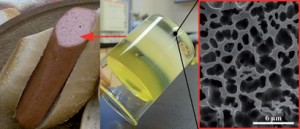Scientists from Finland have shown that a spread containing milk peptides and plant sterols could lower systolic blood pressure and LDL (low density lipoprotein) cholesterol levels.
Cardiovascular disease rates are increasing around the world and its prevention is therefore becoming more pressing, particularly as the disease is typically at an advanced stage when symptoms appear. The spread was developed by Anu Turpeinen at Valio, a company that manufactures dairy products in Helsinki, and colleagues. It offers an economical option in which only a small lifestyle change is required to enjoy the benefits and side-effects are minimal.
The milk peptides are thought to be responsible for the antihypertensive – blood pressure reducing – effects by inhibiting a blood pressure regulator called angiotensin converting enzyme. The lowered LDL cholesterol levels are attributed to the plant sterols preventing intestinal cholesterol absorption, but further research is required on the precise mechanisms of action.
![Butter_and-_Milk_shutterstock_39279025[1]_250_tcm18-215194 Butter and Milk](https://blogs.rsc.org/fo/files/2012/03/Butter_and-_Milk_shutterstock_392790251_250_tcm18-215194.jpg)
The spread combines the blood pressure reducing effect of milk and the cholesterol lowering effect of plant sterols
Read the full article in Chemistry World
Link to journal article
A spread containing bioactive milk peptides Ile–Pro–Pro and Val–Pro–Pro, and plant sterols has antihypertensive and cholesterol-lowering effects
Anu M. Turpeinen , Mikko Ikonen , Anne S. Kivimäki , Hannu Kautiainen , Heikki Vapaatalo and Riitta Korpela
Food Funct., 2012, Advance Article, DOI: 10.1039/C2FO10286B













